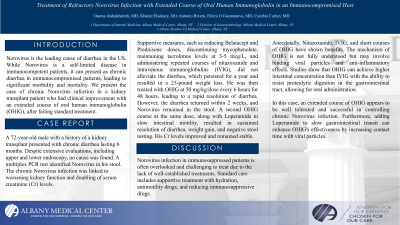Monday Poster Session
Category: Small Intestine
P3305 - Treatment of Refractory Norovirus Infection With Extended Course of Oral Human Immunoglobulin in an Immunocompromised Host
Monday, October 28, 2024
10:30 AM - 4:00 PM ET
Location: Exhibit Hall E

Has Audio

Osama Alshakhatreh, MD
Albany Medical Center
Albany, NY
Presenting Author(s)
Osama Alshakhatreh, MD1, Khaled Elsokary, DO1, Antonio E Rivera, PharmD2, Elvira O Gosmanova, MD2, Cynthia Carlyn, MD2
1Albany Medical Center, Albany, NY; 2Albany Stratton VA Medical Center, Albany, NY
Introduction: Norovirus is the leading cause of diarrhea in the US. While Norovirus is a self-limited disease in immunocompetent patients, it can present as chronic diarrhea in immunocompromised patients, leading to significant morbidity and mortality. We present the case of chronic Norovirus infection in a kidney transplant patient who had clinical improvement with an extended course of oral human immunoglobulin (OHIG), after failing supportive treatment.
Case Description/Methods: A 72-year-old male with a history of a kidney transplant presented with chronic diarrhea lasting 6 months. Despite extensive evaluations, including upper and lower endoscopy, no cause was found. A multiplex PCR test identified Norovirus in his stool. The chronic Norovirus infection was linked to worsening kidney function and doubling of serum creatinine (Cr) levels. Supportive measures, such as reducing Belatacept and Prednisone doses, discontinuing mycophenolate, maintaining tacrolimus levels at 3-5 mcg/L, and administering repeated courses of nitazoxanide and intravenous immunoglobulins (IVIG), did not alleviate the diarrhea, which persisted for a year and resulted in a 25-pound weight loss. He was then treated with OHIG at 50 mg/kg/dose every 6 hours for 48 hours, leading to a rapid resolution of diarrhea. However, the diarrhea returned within 2 weeks, and Norovirus remained in the stool. A second OHIG course at the same dose, along with Loperamide to slow intestinal motility, resulted in sustained resolution of diarrhea, weight gain, and negative stool testing. His Cr levels improved and remained stable.
Discussion: Norovirus infection in immunosuppressed patients is often overlooked and challenging to treat due to the lack of well-established treatments. Standard care includes supportive treatment with hydration, antimotility drugs, and reducing immunosuppressive drugs. Anecdotally, Nitazoxanide, IVIG, and short courses of OHIG have shown benefits.
The mechanism of OHIG is not fully understood but may involve binding viral particles and anti-inflammatory effects. Studies show that OHIG can achieve higher intestinal concentration than IVIG with the ability to resist proteolytic digestion in the gastrointestinal tract, allowing for oral administration.
In this case, an extended course of OHIG appears to be well tolerated and successful in controlling chronic Norovirus infection. Furthermore, adding Loperamide to slow gastrointestinal transit can enhance OHIG's effectiveness by increasing contact time with viral particles.
Disclosures:
Osama Alshakhatreh, MD1, Khaled Elsokary, DO1, Antonio E Rivera, PharmD2, Elvira O Gosmanova, MD2, Cynthia Carlyn, MD2. P3305 - Treatment of Refractory Norovirus Infection With Extended Course of Oral Human Immunoglobulin in an Immunocompromised Host, ACG 2024 Annual Scientific Meeting Abstracts. Philadelphia, PA: American College of Gastroenterology.
1Albany Medical Center, Albany, NY; 2Albany Stratton VA Medical Center, Albany, NY
Introduction: Norovirus is the leading cause of diarrhea in the US. While Norovirus is a self-limited disease in immunocompetent patients, it can present as chronic diarrhea in immunocompromised patients, leading to significant morbidity and mortality. We present the case of chronic Norovirus infection in a kidney transplant patient who had clinical improvement with an extended course of oral human immunoglobulin (OHIG), after failing supportive treatment.
Case Description/Methods: A 72-year-old male with a history of a kidney transplant presented with chronic diarrhea lasting 6 months. Despite extensive evaluations, including upper and lower endoscopy, no cause was found. A multiplex PCR test identified Norovirus in his stool. The chronic Norovirus infection was linked to worsening kidney function and doubling of serum creatinine (Cr) levels. Supportive measures, such as reducing Belatacept and Prednisone doses, discontinuing mycophenolate, maintaining tacrolimus levels at 3-5 mcg/L, and administering repeated courses of nitazoxanide and intravenous immunoglobulins (IVIG), did not alleviate the diarrhea, which persisted for a year and resulted in a 25-pound weight loss. He was then treated with OHIG at 50 mg/kg/dose every 6 hours for 48 hours, leading to a rapid resolution of diarrhea. However, the diarrhea returned within 2 weeks, and Norovirus remained in the stool. A second OHIG course at the same dose, along with Loperamide to slow intestinal motility, resulted in sustained resolution of diarrhea, weight gain, and negative stool testing. His Cr levels improved and remained stable.
Discussion: Norovirus infection in immunosuppressed patients is often overlooked and challenging to treat due to the lack of well-established treatments. Standard care includes supportive treatment with hydration, antimotility drugs, and reducing immunosuppressive drugs. Anecdotally, Nitazoxanide, IVIG, and short courses of OHIG have shown benefits.
The mechanism of OHIG is not fully understood but may involve binding viral particles and anti-inflammatory effects. Studies show that OHIG can achieve higher intestinal concentration than IVIG with the ability to resist proteolytic digestion in the gastrointestinal tract, allowing for oral administration.
In this case, an extended course of OHIG appears to be well tolerated and successful in controlling chronic Norovirus infection. Furthermore, adding Loperamide to slow gastrointestinal transit can enhance OHIG's effectiveness by increasing contact time with viral particles.
Disclosures:
Osama Alshakhatreh indicated no relevant financial relationships.
Khaled Elsokary indicated no relevant financial relationships.
Antonio E Rivera indicated no relevant financial relationships.
Elvira O Gosmanova indicated no relevant financial relationships.
Cynthia Carlyn indicated no relevant financial relationships.
Osama Alshakhatreh, MD1, Khaled Elsokary, DO1, Antonio E Rivera, PharmD2, Elvira O Gosmanova, MD2, Cynthia Carlyn, MD2. P3305 - Treatment of Refractory Norovirus Infection With Extended Course of Oral Human Immunoglobulin in an Immunocompromised Host, ACG 2024 Annual Scientific Meeting Abstracts. Philadelphia, PA: American College of Gastroenterology.
